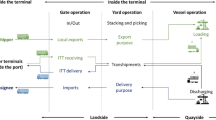Abstract
This paper considers a berth allocation problem (BAP) which requires the determination of exact berthing times and positions of incoming ships in a container port. The problem is solved by optimizing the berth schedule so as to minimize concurrently the three objectives of makespan, waiting time, and degree of deviation from a predetermined priority schedule. These objectives represent the interests of both port and ship operators. Unlike most existing approaches in the literature which are single-objective-based, a multi-objective evolutionary algorithm (MOEA) that incorporates the concept of Pareto optimality is proposed for solving the multi-objective BAP. The MOEA is equipped with three primary features which are specifically designed to target the optimization of the three objectives. The features include a local search heuristic, a hybrid solution decoding scheme, and an optimal berth insertion procedure. The effects that each of these features has on the quality of berth schedules are studied.
Similar content being viewed by others
References
Bosman, P., & Thierens, D. (2003). The balance between proximity and diversity in multi-objective evolutionary algorithms. IEEE Transactions on Evolutionary Computation, 7(2), 174–188.
Brown, G. G., Lawphongpanich, S., & Thurman, K. P. (1994). Optimizing ship berthing. Naval Research Logistics, 41, 1–15.
Brown, G. G., Cormican, K. J., Lawphongpanich, S., & Widddis, D. B. (1997). Optimizing submarine berthing with a persistence incentive. Navel Research Logistics, 44, 301–318.
Cheong, C. Y., Tan, K. C., & Veeravalli, B. (2007). Solving the exam timetabling problem via a multi-objective evolutionary algorithm—a more general approach. In Proceedings of the 2007 IEEE Symposium on Computational Intelligence in Scheduling, CI-Sched 2007 (pp. 165–172), Honolulu, HI, USA, 2007.
Deb, K. (2001). Multi-objective optimization using evolutionary algorithms. New York: Wiley.
Fonseca, C. M. (1995). Multiobjective genetic algorithms with application to control engineering problems. Ph.D. thesis, Department of Automatic Control and Systems Engineering, University of Sheffield, Sheffield, UK.
Foo, H. M. (2000). The application of genetic algorithms to the berth allocation problem. Master thesis, Department of Computer Science, Faculty of Science, National University of Singapore, Singapore.
Guan, Y., Xiao, W.-Q., Cheung, R. K., & Li, C.-L. (2002). A multiprocessor task scheduling model for berth allocation: heuristic and worst case analysis. Operations Research Letters, 30, 343–350.
Imai, A., Nagaiwa, K., & Chan, W. T. (1997). Efficient planning of berth allocation for container terminals in Asia. Journal of Advanced Transportation, 31, 75–94.
Imai, A., Nishimura, E., & Papadimitriou, S. (2001). The dynamic berth allocation problem for a container port. Transportation Research Part B: Methodological, 35(4), 401–417.
Imai, A., Nishimura, E., & Papadimitriou, S. (2003). Berth allocation with service priority. Transportation Research Part B: Methodological, 37(5), 437–457.
Imai, A., Sun, X., Nishimura, E., & Papadimitriou, S. (2005). Berth allocation in a container port: using a continuous location space approach. Transportation Research Part B: Methodological, 39(3), 199–221.
Imai, A., Nishimura, E., Hattori, M., & Papadimitriou, S. (2007). Berth allocation at indented berths for mega-containerships. European Journal of Operational Research, 179(2), 579–593.
Kim, K. H., & Moon, K. C. (2003). Berth scheduling by simulated annealing. Transportation Research Part B: Methodological, 37(6), 541–560.
Lai, K. K., & Shih, K. (1992). A study of container berth allocation. Journal of Advanced Transportation, 26, 45–60.
Li, C.-L., Cai, X., & Lee, C.-Y. (1998). Scheduling with multiple-job-on-one-processor pattern. IIE Transactions, 30, 433–445.
Lim, A. (1998). The berth planning problem. Operations Research Letters, 22(2–3), 105–110.
Nishimura, E., Imai, A., & Papadimitriou, S. (2001). Berth allocation planning in the public berth system by genetic algorithms. European Journal of Operational Research, 131(2), 282–292.
Park, K. T., & Kim, K. H. (2002). Berth scheduling for container terminals by using a sub-gradient optimization technique. Journal of the Operational Research Society, 53, 1054–1062.
Park, Y.-M., & Kim, K. H. (2003). A scheduling method for berth and quay cranes. OR Spectrum, 25, 1–23.
Ross, P., & Corne, D. (1994). Applications of genetic algorithms. AISB Quarterly, 89, 23–30.
Tan, K. C., Cheong, C. Y., & Goh, C. K. (2007). Solving multi-objective vehicle routing problem with stochastic demand via evolutionary computation. European Journal of Operational Research, 177, 813–839.
Ying, Y. M. (1995). Berth allocation planning using genetic algorithms. Master thesis, Department of Civil Engineering, Faculty of Engineering, National University of Singapore, Singapore.
Zitzler, E., & Thiele, L. (1999). Multi-objective evolutionary algorithms: a comparative case study and the strength Pareto approach. IEEE Transactions on Evolutionary Computation, 3(4), 257–271.
Zitzler, E., Deb, K., & Thiele, L. (2000). Comparison of multi-objective evolutionary algorithms: empirical results. Evolutionary Computation, 8(2), 173–195.
Zitzler, E., Thiele, L., Laumanns, M., Fonseca, C. M., & Fonseca, V. G. (2003). Performance assessment of multi-objective optimizers: an analysis and review. IEEE Transactions on Evolutionary Computation, 7(2), 117–132.
Author information
Authors and Affiliations
Corresponding author
Rights and permissions
About this article
Cite this article
Cheong, C.Y., Tan, K.C., Liu, D.K. et al. Multi-objective and prioritized berth allocation in container ports. Ann Oper Res 180, 63–103 (2010). https://doi.org/10.1007/s10479-008-0493-0
Published:
Issue Date:
DOI: https://doi.org/10.1007/s10479-008-0493-0




